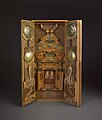Kotohira-gū
From Wikipedia, the free encyclopedia
Kotohira-gū (金刀比羅宮) (also known as Konpira-dai-gongen (金比羅大権現), Konpira-san (こんぴらさん), or Konpira Shrine in English) is a Shinto shrine in the town of Kotohira in Kagawa, Japan. This shrine is patron of sea ship transport and sailors.
This article needs additional citations for verification. (December 2022) |
| Kotohira-gū (金刀比羅宮) | |
|---|---|
 Haiden of main shrine (本宮 hon-gū), Kotohira Shrine | |
| Religion | |
| Affiliation | Shinto |
| Deity | Ōmononushi (Konpira Gongen) |
| Location | |
| Geographic coordinates | 34°11′03″N 133°48′35″E |
It is a Kotohira Shrine or one dedicated to Ōmononushi. It is the head of a network with 683 shrines in it.[1][2]
Located at 521 metres (1,709 ft) halfway up Mount Zōzu, the shrine stands at the end of a long path, with 785 steps to reach the main shrine and a total of 1368 steps to the inner shrine. Since the Muromachi period, pilgrimages to the shrine became popular, and even today usually hundreds of visitors in a day climb the steps of Mount Zōzu. On the way to the shrine is a sake museum, stores, and stones with the names of donors carved in kanji. The shrine sells a yuzu-flavored hard candy called kamiyo ame. Visitors break the candy with a small hammer to share pieces (and good fortune) with those who are not able to manage the difficult climb.[3]
Before the Meiji era, Kotohira Shrine was also a Buddhist site as well (see honji suijaku).
History
It is said to have been founded during the 1st century.[citation needed]
The principal kami of the shrine is Ō-mono-nushi-no-mikoto, a spirit associated with seafaring (also referred to as the Buddhist deity Konpira). In 1165 the spirit of Emperor Sutoku was also enshrined.
Before the Meiji era, it was known as Konpira-Daigongen (金比羅大権現), and it stood at the head of the nationwide group of shrines bearing the names, Kompira and Kotohira. The ema hall is the site for offering prayers for safe seafaring. The Konpira temple was transformed into a Shinto shrine and renamed Kotohira in 1889.[4]
From 1871 through 1946, Kotohira was officially designated one of the kokuhei-chūsha (国幣中社), meaning that it stood in the mid-range of ranked, nationally significant shrines.
On June 5, 2020, Kotohira Shrine sent a notice to the Association of Shinto Shrines stating that it would abolish its inclusive relationship, due to the fact that the heihaku to be delivered on the day of the Daijō-sai accompanying the enthronement of the Emperor in the first year of Reiwa (2019) was not sent. In November 2020, the withdrawal from the Association was approved and it became a standalone shrine.[5]
Matsuo-ji

Matsuo-ji is a temple located nearby that used to run Kotohira-gu. It is affiliated with the Koyasan Shingon sect.
It was founded by En no Gyōja when he had a vision of Konpira Gongen at the site.
Treasures
Kompira Shrine has several Important Cultural Properties, including a Heian period statue of the eleven-faced Kannon Bosatsu and four ink paintings by Maruyama Ōkyo.
Gallery
- Hongū (main shrine) complex
- Honden of the hongū
- Mihotsu Jinja's haiden of the hongū
- Kaguraden of the hongū
- Asahi-sha
- Homotsukan museum
- Kompira Shrine Votive Box, c. 1800–1894, from the Oxford College Archives of Emory University
See also
Notes
External links
Wikiwand in your browser!
Seamless Wikipedia browsing. On steroids.
Every time you click a link to Wikipedia, Wiktionary or Wikiquote in your browser's search results, it will show the modern Wikiwand interface.
Wikiwand extension is a five stars, simple, with minimum permission required to keep your browsing private, safe and transparent.








